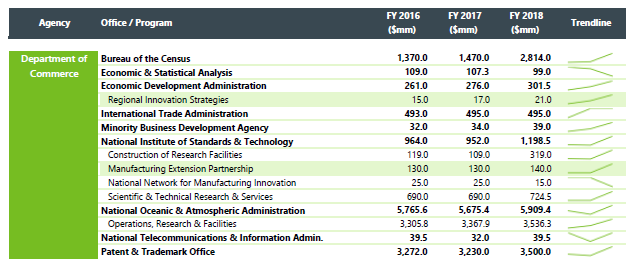In the immediate aftermath of the FY 2018 federal budget deal’s announcement, SSTI covered the increased funding for a few key programs, including Regional Innovation Strategies ($21 million) and the National Science Foundation ($7.5 billion). Today we reveal our full analysis covering several new funding line items and substantial funding increases for regional innovation organizations to consider.
For even more information on science and innovation funding in the FY 2018 budget, review SSTI’s new federal science and innovation budget tracking report. The document, which can be found here, lists more than 220 line items across 19 agencies with funding levels from FY 2016-2018 and highlights programs of note. An snippet of the report can be found below.
New Funding
- Dept. of Agriculture, Rural Development: Rural Broadband Pilot Program – $600 million – Congress provides substantial funding for a new initiative “closing the digital divide” with an explicit emphasis on prioritizing access and being open to any technology that can meet the broader goal.
- Dept. of Defense: Defense Innovation Unit Experimental (DIUX) – $23.6 million – While this initiative to help develop startups and connect them with defense-related procurement is not new, this appears to be the first time (at least since before FY 2016) it is receiving its own line item.
- Customs & Border Patrol: Commercial Technology Innovation Program – $10 million – This funding is to deploy innovations that can improve security at points-of-entry along the southwest border. The office is required to report on its progress within 90 days.
- White House: National Space Council – $2 million – The council was reestablished last summer and held a meeting for agency representatives in the fall and hosted an advisory council this February.
Big Winners
- Dept. of Homeland Security divisional R&D budgets: Coast Guard – 11x/$26.6 million increase to $29.1 million | National Protection & Programs Directorate – 2x/$8.6 million increase to $20.2 million | Transportation Security Administration – 4x/$15.2 million increase to $20.2 million – While the department’s primary R&D and S&T budgets saw slight changes, these three divisions saw some of the largest percentage gains among all innovation-related line items, although the total invested remains small.
- Dept. of Labor: Apprenticeship Grants – 53 percent/$50 million increase to $145 million – The notable exception of the border wall notwithstanding, the substantial investment in apprenticeships is another example of Congress being supportive when the administration seeks funding.
- Dept. of Defense: Research, Development, Test & Evaluation – 22 percent/$16 billion increase to $88.3 billion – The gain is particularly notable for the Air Force, which increased its R&D budget by more than $9 billion. Defense-wide spending will increase by nearly $3.5 billion. Manufacturing development activities seem to be particularly strong targets for these increases.
- Economic Development Administration: Regional Innovation Strategies – 24 percent/$4 million increase to $21 million – The program received the third-largest percentage increase for an innovation-related line item from the appropriations subcommittee that controls funding for commerce, justice and science agencies (after construction projects at NIST and Hispanic-serving institutions funding at NSF).
